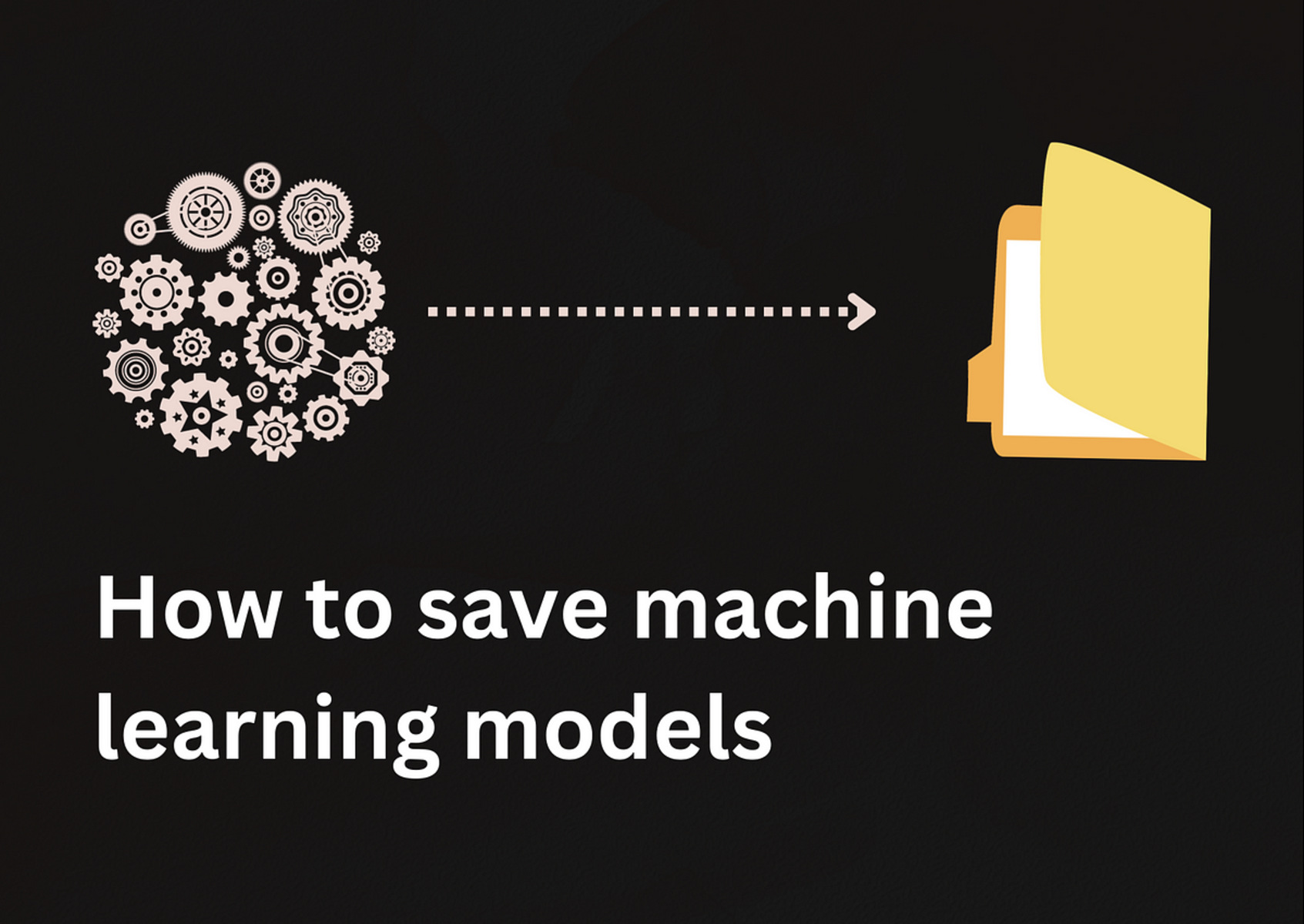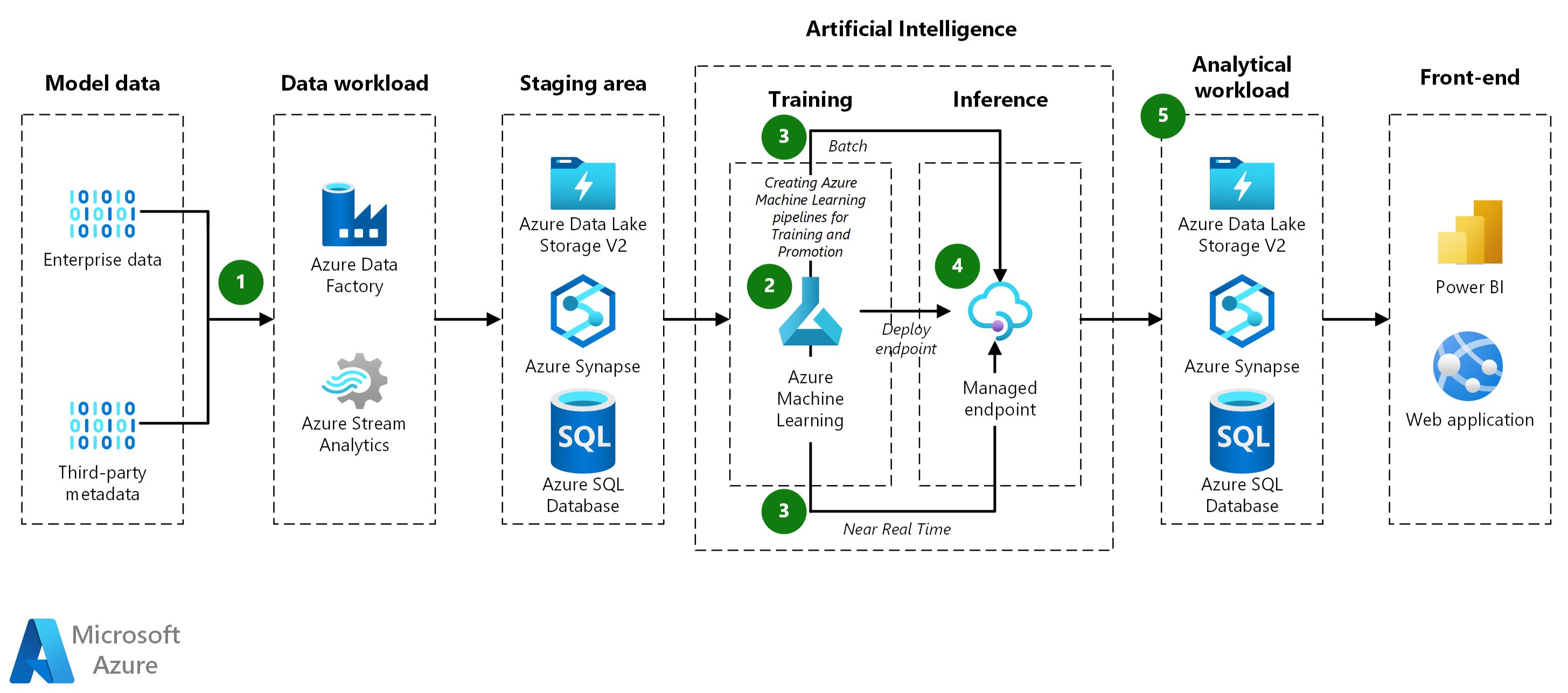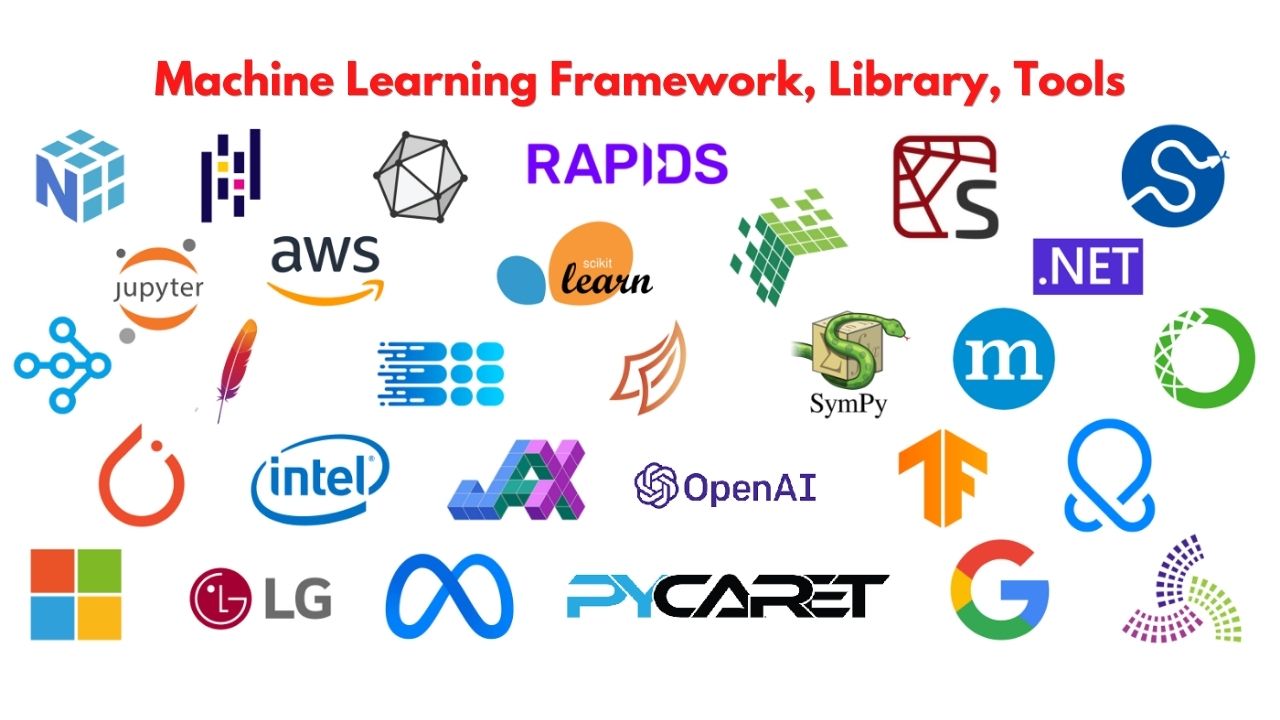Introduction
Machine learning models play a crucial role in modern data-driven applications. They enable us to make predictions, derive insights, and automate decision-making processes. These models are built using complex algorithms and trained on vast amounts of data, making them valuable assets that need to be stored and preserved.
Saving machine learning models is essential for several reasons. Firstly, it allows us to reuse and deploy the models in different environments without the need to retrain them from scratch. This is particularly important when working with large datasets or computationally intensive algorithms.
Additionally, saving models enables collaboration and knowledge sharing among data scientists and machine learning practitioners. By saving and sharing models, researchers can replicate experiments, validate results, and build upon existing work.
There are various approaches to saving machine learning models, each with its own advantages and considerations. In this article, we will explore common methods for saving models in popular programming languages such as Python and R, as well as frameworks like TensorFlow and PyTorch. We will also discuss the importance of choosing the right format for model saving and highlight best practices to ensure the integrity and usability of saved models.
Whether you are a data scientist, machine learning engineer, or researcher, understanding how to effectively save machine learning models is an essential skill that will enable you to leverage the power of your models and accelerate your projects. So, let’s dive into the different approaches and considerations for saving machine learning models!
Why Save Machine Learning Models?
Saving machine learning models is crucial for their reuse, deployment, and collaboration among data scientists and researchers. Let’s delve into the reasons why saving machine learning models is essential.
Reusability: Saving models allows us to reuse them in different settings without the need to retrain from scratch. This is beneficial when working with large datasets or computationally expensive algorithms. By saving models, we can easily load and apply them to new data, saving time and computational resources.
Deployment: Saving models enables their deployment in various environments, such as web applications, mobile devices, or embedded systems. Once a model is saved, it can be integrated into software systems, allowing real-time predictions and decision making based on new data.
Sharing and Collaboration: Saving models facilitates collaboration among data scientists and researchers. By sharing saved models, individuals can replicate experiments, validate results, and build upon existing work. This promotes knowledge sharing and accelerates the development of new machine learning applications.
Experiment Replicability: Saving models is essential for reproducibility in machine learning experiments. By saving both the model and associated parameters, researchers can replicate the exact state of the model and reproduce results. This ensures transparency and allows for validation and benchmarking of different approaches.
Model Interpretability: Saving models allows for model interpretation and explanation. In some cases, it is important to understand how the model arrived at its predictions. By saving the model, researchers can analyze its inner workings, visualize features, and gain insights into the decision-making process.
Disaster Recovery: Saving models is a form of insurance against accidental loss or corruption. Data scientists invest significant time and resources in training models, and losing them would be detrimental to the progress of a project. By saving models, they can be easily restored and prevent the need for time-consuming retraining.
Overall, saving machine learning models provides numerous benefits such as reusability, deployment flexibility, collaboration, reproducibility, interpretability, and disaster recovery. By ensuring that models are properly saved, data scientists can maximize the value and impact of their work without the need to reinvent the wheel.
Common Approaches to Saving Models
When it comes to saving machine learning models, there are several commonly used approaches. Let’s explore some of these approaches.
Pickle Serialization: One of the simplest approaches is to use the pickle module in Python. Pickle serialization allows models to be saved in a binary format, preserving their state, including trained parameters and the structure of the model itself. Pickle serialization is convenient for saving and loading models in Python, but it may not be compatible with other programming languages.
Joblib Serialization: Joblib is another popular library in Python for saving machine learning models. It provides efficient serialization and deserialization of models, making it a good alternative to pickle, especially when dealing with large models or large datasets. Joblib also supports multi-threading, which can speed up the saving and loading process.
SaveRDS in R: In R, the SaveRDS function is commonly used to save machine learning models. It creates a serialized representation of the model and can be easily loaded using the readRDS function. SaveRDS is a convenient approach for saving models in R and allows for compatibility across different R packages and environments.
TensorFlow SavedModel: If you are working with TensorFlow, you can save your models using the SavedModel format. This format provides a standardized way to save models, including their architecture, weights, and training configuration. SavedModel also supports serving models in production environments using TensorFlow serving.
PyTorch Serialization: PyTorch provides various methods for saving models, including the state_dict, which saves only the learned parameters of the model, and the torch.save function, which saves the entire model object. These approaches make it easy to save and load PyTorch models, allowing for seamless deployment and sharing.
When selecting an approach to save machine learning models, it is crucial to consider factors such as compatibility, ease of use, and efficiency. Depending on the programming language, framework, and specific requirements of your project, you can choose the approach that best fits your needs.
Now that we have explored the common approaches to saving machine learning models, let’s dive into the specific techniques for saving models in Python, R, TensorFlow, and PyTorch frameworks.
Saving Models in Python
Python provides several options for saving machine learning models. Here are some commonly used techniques:
Pickle: The pickle module in Python allows for easy serialization and deserialization of objects, including machine learning models. You can save a model using the pickle.dump() function and load it with pickle.load(). Keep in mind that pickle may not be compatible with other programming languages and may have security vulnerabilities when loading untrusted data.
Joblib: The joblib library provides an efficient way to serialize and deserialize Python objects, including machine learning models. It is particularly useful for large models or datasets. You can save a model using joblib.dump() and load it with joblib.load(). Joblib also supports compression and multi-threading, providing faster saving and loading times.
JSON: If you prefer a human-readable format, you can save the model’s architecture and parameters as a JSON file. You can convert the model to a dictionary using the .to_json() method and then save it using the json.dump() function. To load the model, you can use json.load() and then convert it back to the desired model format.
YAML: Similar to JSON, YAML is another human-readable format that can be used to save machine learning models. You can use the PyYAML library to save the model’s architecture and parameters as a YAML file. First, convert the model to a dictionary using the .to_dict() method and then save it using PyYAML’s dump() function. To load the model, use yaml.load() and convert it back to the appropriate format.
TensorFlow SavedModel: If you are working with TensorFlow, you can save models using the SavedModel format. This format captures the model’s structure, variables, and operations together for easy loading and serving. You can save a model using the tf.saved_model.save() function and load it with tf.saved_model.load(). Saved models are portable across different TensorFlow versions and can be used for deployment in production environments.
PyTorch Serialization: PyTorch provides various methods for saving models. The most common approach is to save the model’s state_dict, which contains the learned parameters. You can save the state_dict using the torch.save() function and load it with torch.load(). Another approach is to save the entire model object, which includes the architecture and parameters. This can be done using the torch.save() function as well.
These are some of the common techniques for saving machine learning models in Python. When selecting an approach, consider factors such as compatibility, ease of use, and the specific requirements of your project. Now, let’s explore how to save models in other programming languages and frameworks.
Saving Models in R
When working with R, there are several approaches you can take to save machine learning models. Here are some commonly used techniques:
SaveRDS: In R, the SaveRDS function allows you to save an R object, including machine learning models, in a serialized format. You can use SaveRDS to save a model by specifying the R object and the file path. To load the saved model, you can use the readRDS function. SaveRDS is a versatile and widely supported method for saving models in R.
pmml: The pmml package in R provides functionality to save models in the Predictive Model Markup Language (PMML) format. PMML is an XML-based format that allows machine learning models to be shared between different tools and platforms. You can utilize the pmml package to convert your R models to PMML and save them as XML files. Saved PMML models can then be loaded into other applications or frameworks.
Serialization with JSON: If you prefer a human-readable format, you can save the model’s parameters and metadata in a JSON file. You can use the toJSON function from the jsonlite package to convert your model to a JSON format and then save it using the write_json function. To load the saved model, you can use the read_json function and convert it back to the desired model format.
Serialization with YAML: Similarly to JSON, you can also save models in YAML format in R. The yaml package provides functions such as as.yaml and write_yaml to convert R objects, including models, to YAML format and save them as YAML files. To load the saved model, you can use the read_yaml function and convert it back to the appropriate format.
RData: Another approach in R is to save models along with other objects in a single RData file using the save function. By specifying the objects you want to save, including the model, you can store them in an RData file. To load the saved model, you can use the load function to restore the objects from the file.
These are some of the common techniques for saving machine learning models in R. Depending on your specific requirements and preferences, you can select the approach that best fits your needs. Now, let’s move on to exploring how to save models in popular frameworks like TensorFlow and PyTorch.
Saving Models in TensorFlow
TensorFlow offers various methods for saving machine learning models. Let’s explore some commonly used techniques:
SavedModel: TensorFlow’s SavedModel format is a comprehensive solution for saving models. It includes the model’s architecture, variables, and the computation graph, which allows for easy deployment and serving of models. You can save a model in the SavedModel format using the tf.saved_model.save() function and load it with tf.saved_model.load().
tf.train.Checkpoint: The tf.train.Checkpoint API provides a flexible and efficient way to save and restore TensorFlow models. With checkpoints, you can save specific variables or the entire model, allowing fine-grained control over what gets saved. You can save a checkpoint using tf.train.Checkpoint.save() and restore variables using tf.train.Checkpoint.restore().
tf.keras.models.save_model: If you are using Keras, TensorFlow’s high-level API, you can save your models using the tf.keras.models.save_model() function. This function saves the model’s architecture, including the layers, activations, and configurations, as well as the learned parameters. You can then reload the model using tf.keras.models.load_model().
tf.saved_model.simple_save: For simpler models without custom training loops or multiple subgraphs, tf.saved_model.simple_save() provides a convenient way to save models. This function takes in the model’s inputs, outputs, and signatures and saves them in the SavedModel format. It is a lightweight option for saving models quickly and easily.
GraphDef and MetaGraphDef: TensorFlow also allows for saving models in the GraphDef and MetaGraphDef formats. GraphDef stores the computation graph structure, while MetaGraphDef includes additional metadata like variables and signatures. You can save a GraphDef using tf.train.write_graph() and a MetaGraphDef using tf.train.export_meta_graph().
These are some of the common techniques for saving machine learning models in TensorFlow. The choice of approach depends on factors such as the complexity of your model, the need for underlying graph information, and the compatibility with other TensorFlow tools and frameworks.
Now, let’s explore how to save models in the PyTorch framework.
Saving Models in PyTorch
PyTorch provides several methods for saving machine learning models. Let’s take a look at some commonly used techniques:
State Dict: The most common approach in PyTorch is to save the state_dict of the model. The state_dict is a Python dictionary that maps each parameter to its corresponding tensor. You can save the state_dict using the torch.save() function, and later load it using torch.load(). This approach facilitates sharing and reusing model parameters without saving the entire model object.
Complete Model Object: PyTorch also allows you to save the complete model object, which includes the architecture, parameters, optimizer state, and any additional attributes defined in the model class. You can save the entire model object using the torch.save() function and load it with torch.load(). This approach is useful when you want to preserve the entire model for deployment or further training.
ONNX: PyTorch supports the Open Neural Network Exchange (ONNX) format, which enables interoperability between different deep learning frameworks. By converting your PyTorch model to the ONNX format, you can save it and load it into other frameworks such as TensorFlow or Caffe. You can use the torch.onnx.export() function to export your PyTorch model to ONNX.
TorchScript: TorchScript is a way to create serializable and optimizable models in PyTorch. By scripting your model with the @torch.jit.script decorator, you can save the TorchScript representation of your model to a file using the torch.jit.save() function. The saved TorchScript can be loaded with torch.jit.load() and executed without the need for the original Python code.
These techniques offer flexibility and compatibility when saving PyTorch models. Depending on your specific needs, you can choose to save just the state_dict, the complete model object, or explore options like ONNX and TorchScript.
Now that we have covered the techniques for saving models in PyTorch, let’s move on to discussing the importance of choosing the right format for model saving.
Choosing the Right Format for Model Saving
When saving machine learning models, it is crucial to choose the right format to ensure compatibility, efficiency, and ease of use. Here are some factors to consider when selecting the format for model saving:
Framework Compatibility: Choose a format that is compatible with the framework you are using. For example, if you are working with TensorFlow, using the SavedModel format would be a natural choice. If you are working with PyTorch, saving the state_dict or using TorchScript could be suitable options. Compatibility ensures that the saved model can be easily loaded and used within the same framework.
Interoperability: If you need to use the saved model in multiple frameworks or tools, consider formats that support interoperability. For instance, saving models in ONNX format allows for sharing models between different deep learning frameworks such as PyTorch and TensorFlow. This can be beneficial when collaborating with others or integrating models into different production systems.
Serialization Efficiency: Consider the size and efficiency of the serialized format. Some formats, like pickle, may result in large file sizes. In such cases, joblib serialization or saving only the needed components of the model, such as the state_dict, may be more efficient. Smaller file sizes enable faster storage, transfer, and loading of the model, which can be crucial for large models or limited computing resources.
Human-Readable or Compact: Choose a format based on your preference for readability or compactness. If you value human-readable formats, options like JSON or YAML may be suitable. These formats make it easier to inspect and understand the saved model structure and parameters. On the other hand, binary or serialized formats like the state_dict or SavedModel are more compact, providing faster loading and fewer storage requirements.
Additional Metadata: Consider whether you need to save additional metadata along with the model. Some formats, like SavedModel and complete model objects, can include information about the model’s architecture, optimizer state, or custom attributes defined in the model class. This metadata can be useful for model interpretation, understanding the model’s history, or resuming training from a specific checkpoint.
By considering these factors, you can select the format that best aligns with your specific use case and requirements. It is worth noting that different formats may have different trade-offs, so it is important to evaluate them based on your specific needs.
Now that we understand the importance of choosing the right format for model saving, let’s move on to discussing considerations for saving deep learning models.
Considerations for Saving Deep Learning Models
When saving deep learning models, there are several considerations to keep in mind to ensure the integrity and usability of the saved models:
Versioning: Deep learning frameworks and libraries frequently release updates that may impact model compatibility. It is important to keep track of the versions of the frameworks and libraries used in model training. Saving the version information alongside the model can help ensure reproducibility and compatibility when loading the model in the future.
Dependencies: Deep learning models often rely on external dependencies, such as specific versions of Python packages or custom modules. It is important to maintain a record of these dependencies and save them along with the model. Storing this information can help recreate the environment needed to load and run the model properly.
Data Preprocessing: Deep learning models often require data preprocessing steps, such as normalization or feature scaling. It is important to save the necessary preprocessing steps along with the model to ensure consistent and accurate data transformation when the model is loaded. This can include saving the preprocessor object or any associated transformation parameters.
Hardware Considerations: Deep learning models may be trained and utilized on specific hardware configurations (e.g., GPU). It is important to take into account the hardware requirements when saving models. If the model relies on specific hardware resources, it is important to note these requirements and consider them when deploying or sharing the model.
Model Documentation: Proper documentation of the saved model is essential for its usability and future reference. Documenting the model’s architecture, training methodology, hyperparameters, and any specific implementation details helps ensure that the saved model can be accurately understood and effectively utilized by others.
Code Version Control: Saving the code used to train and create the model is important for reproducibility and future modifications. By preserving the code in a version control repository, such as Git, developers can refer back to the exact code version and reproduce the model or make necessary modifications.
By considering these factors, deep learning practitioners can ensure that the saved models are complete, well-documented, and can be easily loaded and utilized in the future. Taking these considerations into account helps ensure reproducibility, compatibility, and proper implementation of the deep learning models.
Now that we have discussed the considerations for saving deep learning models, let’s move on to exploring best practices for saving machine learning models in general.
Best Practices for Saving Machine Learning Models
When saving machine learning models, following these best practices can ensure the integrity, usability, and reproducibility of the saved models:
Version Control: Use a version control system, such as Git, to manage and track changes to your models and their associated code. This allows you to easily revert to previous versions, compare changes, and collaborate with others effectively.
Metadata Documentation: Document important metadata about the model, such as the date of saving, the dataset used, preprocessing techniques, hyperparameters, and any relevant configurations or assumptions. This documentation will help understand the context and conditions under which the model was developed and can aid in reproducibility.
Data Versioning: Make sure to store information about the version of the dataset used to train the model. Data is an integral part of machine learning, and having accurate and consistent data versions helps ensure the reproducibility of the model’s performance.
Model Evaluation Metrics: Record the evaluation metrics used to assess the model’s performance. This includes metrics like accuracy, precision, recall, or any other domain-specific metrics. Having these metrics readily available alongside the saved model helps evaluate the model’s performance and compare it with other models in the future.
Documentation of Dependencies: Keep track of the software dependencies required to run the model effectively. Document the versions of programming languages, frameworks, and libraries used. This information helps recreate the exact environment needed to load and run the model correctly.
Testing Saved Models: Validate the integrity of the saved models by testing them before deployment. This involves loading the saved model and running a series of test scenarios to ensure the model behaves as expected. Testing helps catch any errors or compatibility issues that may arise during the saving and loading process.
Maintain Reproducibility: Aim to make your saved models reproducible by providing clear instructions, documentation, and code for others to replicate your results. This includes sharing code, data preprocessing steps, and details of the training process. Reproducibility is essential for scientific rigor and collaboration.
Regular Backup: Regularly back up your saved models to prevent loss or corruption due to unforeseen circumstances. Backing up models ensures that you can restore them if the originals are accidentally deleted or damaged.
By following these best practices, you can ensure that your saved machine learning models are well-documented, reproducible, and easily usable by yourself and others. These practices also establish a foundation for effective collaboration and knowledge sharing among the machine learning community.
Now that we have explored best practices for saving machine learning models, let’s wrap up this article.
Conclusion
Saving machine learning models is a crucial step in ensuring their reusability, deployment, and collaboration among data scientists and researchers. By selecting the right approach and format for model saving, practitioners can efficiently store and share their models, enabling future use in diverse environments and driving knowledge advancement.
In this article, we explored the common approaches to saving models in various programming languages and frameworks. From using pickle and joblib in Python to employing SaveRDS in R, and utilizing formats like SavedModel in TensorFlow and state_dict in PyTorch, each approach offers unique advantages for saving models.
In addition, we discussed important considerations for saving deep learning models, including versioning, dependencies, data preprocessing, and hardware requirements. Adhering to these considerations ensures the integrity and usability of saved models, while also highlighting the significance of documenting metadata, performing rigorous testing, and maintaining regular backups.
By following best practices such as version control, documenting metadata, preserving data versions, and keeping track of model evaluation metrics, machine learning practitioners can enhance reproducibility, collaboration, and the overall usability of their saved models.
In conclusion, understanding how to effectively save machine learning models is essential for maximizing the value and impact of your work. Through thoughtful consideration of format, versioning, metadata, and best practices, you can ensure that your saved models are easily accessible, reproducible, and compatible across different environments. By following these guidelines, you will be well-equipped to preserve the knowledge and insights from your machine learning endeavors.

























